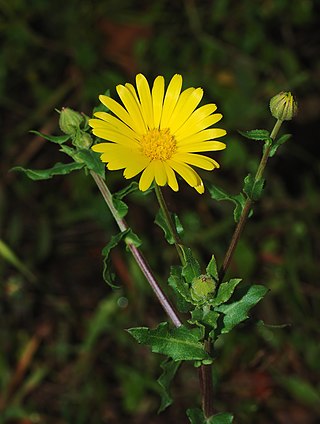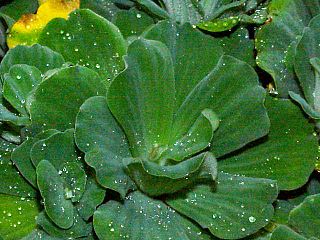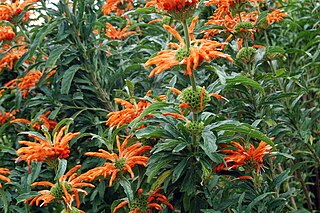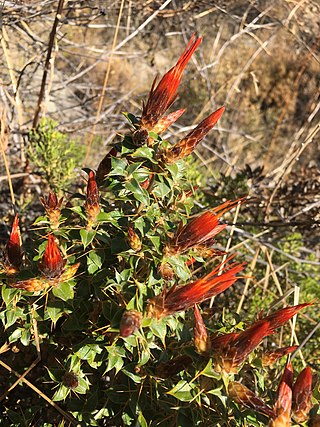
Calendula is a genus of about 15–20 species of annual and perennial herbaceous plants in the daisy family, Asteraceae that are often known as marigolds. They are native to southwestern Asia, western Europe, Macaronesia, and the Mediterranean. Other plants known as marigolds include corn marigold, desert marigold, marsh marigold, and plants of the genus Tagetes.

Abrus precatorius, commonly known as jequirity bean or rosary pea, is a herbaceous flowering plant in the bean family Fabaceae. It is a slender, perennial climber with long, pinnate-leafleted leaves that twines around trees, shrubs, and hedges.

Pistia is a genus of aquatic plants in the arum family, Araceae. It is the sole genus in the tribe Pistieae which reflects its systematic isolation within the family. The single species it comprises, Pistia stratiotes, is often called water cabbage, water lettuce, Nile cabbage, or shellflower. Its native distribution is uncertain but is probably pantropical; it was first scientifically described from plants found on the Nile near Lake Victoria in Africa. It is now present, either naturally or through human introduction, in nearly all tropical and subtropical fresh waterways and is considered an invasive species as well as a mosquito breeding habitat. The specific epithet is derived from a Greek word, στρατιώτης, meaning "soldier", which references the sword-shaped leaves of some plants in the Stratiotes genus.

Solanum nigrum, the European black nightshade or simply black nightshade or blackberry nightshade, is a species of flowering plant in the family Solanaceae, native to Eurasia and introduced in the Americas, Australasia, and South Africa. Ripe berries and cooked leaves of edible strains are used as food in some locales, and plant parts are used as a traditional medicine. Some other species may also be referred to as "black nightshade".

Vernonia is a genus of about 350 species of forbs and shrubs in the family Asteraceae. Some species are known as ironweed. Some species are edible and of economic value. They are known for having intense purple flowers. There have been numerous distinct subgenera and subsections named in this genus, and some botanists have divided the genus into several distinct genera. For instance, the Flora of North America recognizes only about twenty species in Vernoniasensu stricto, seventeen of which are in North America north of Mexico, with the others being found in South America.

Peumus boldus, commonly known as boldo, is a species of tree in the family Monimiaceae and the only species in the genus Peumus. It is endemic to the central region of Chile, between 33° and 40° southern latitude. Boldo has also been introduced to Europe and North Africa, though it is not often seen outside botanical gardens.

Calotropis is a genus of flowering plants in the family Apocynaceae, first described as a genus in 1810. It is native to southern Asia and North Africa.

Leonotis leonurus, also known as lion's tail and wild dagga, is a plant species in the mint family, Lamiaceae. The plant is a broadleaf evergreen large shrub native to South Africa, where it is very common. It is known for its medicinal properties. The main psychoactive component of Leonotis leonurus is hypothesized to be related to the presence of leonurine or labdanes, Leonotis leonurus has been confirmed to contain leonurine according to peer reviewed journal published phytochemical analysis. Like other plants in the mint family, it also contains marrubiin. The word "dagga" comes from Afrikaans, and derives in turn from the Khoikhoi "dachab". The word "dagga" has been extended to include cannabis in Afrikaans and South African English, so the use of "wild" serves to distinguish Leonotis leonurus from this.
Dennettia tripetala is a species of flowering plant in the Annonaceae family. It is a shrub or tree native to western and west-central tropical Africa, including Guinea, Sierra Leone, Ghana, Nigeria, and Cameroon. It is threatened by habitat loss.

Ficus deltoidea, commonly known as mistletoe fig is a species of flowering plant in the family Moraceae, native to Southeast Asia, and widely naturalized in other parts of the world.

Trema orientale is a species of flowering tree in the hemp family, Cannabaceae. It is known by many common names, including charcoal-tree, Indian charcoal-tree, pigeon wood, Oriental trema, and in Hawaii, where it has become naturalized, gunpowder tree, or nalita. It has a near universal distribution in tropical and warm temperate parts of the Old World, with a range extending from South Africa, through the Middle East, the Indian subcontinent and southern China to Southeast Asia and Australia.

Ziziphus oenopolia, commonly known as the jackal jujube, small-fruited jujube or wild jujube, is a flowering plant with a broad distribution through tropical and subtropical Asia and Australasia. In India, it is mostly found in the deciduous forests of the southern part of the country.

Peanut soup or groundnut soup is a soup made from peanuts, often with various other ingredients. It is a staple in African cuisine but is also eaten in East Asia (Taiwan), the United States and other areas around the world. It is also common in some regions, such as Argentina's northwest, Bolivia and Peru, where it can sometimes be served with bone meat and hollow short pasta or fries. In Ghana it is often eaten with fufu, omo tuo and banku and is often very spicy. Groundnut soup is also a native soup of the Benin (Edo) people in Nigeria and it is often eaten with pounded yam. Some of the essential ingredients used in making it are ugu, oziza leaves, Piper guineense and Vernonia amygdalina.

Schkuhria pinnata, the canchalagua or dwarf Mexican marigold, is a small, dainty, pioneer annual herb of the family Asteraceae and widespread in the tropics. It is regarded as a naturalised weed with low ecological impact.

Myrianthus arboreus, the giant yellow mulberry or monkey fruit or Nyankama, in the Akan twi language of Ghana, is a dioecious tropical tree in the genus Myrianthus. It lives in the tropical Central African countries of Central African Republic, Gabon, Cameroon, Nigeria, and Tanzania, and also Ghana in the West African countries. Its chromosome count is 2n = 28.

Chuquiraga spinosa, common name huamanpinta in Spanish, is a species of flowering plant of the family Asteraceae. Native to Perú and Bolivia, it is used in traditional medicine for its anti-inflammatory properties.

Bothriocline longipes is a woody perennial herb or shrub capable of reaching three meters tall. It is part of the family Asteraceae.
Cordia salicifolia, also called Cordia ecalyculata and chá de bugre, is a species of evergreen flowering tree in the borage family, Boraginaceae, that occurs mainly in Brazil and is used as a medicinal plant. Its red fruit, which resembles a coffee bean and contains caffeine, is roasted and brewed as a coffee substitute.

Asparagus africanus, also known as African asparagus, bush asparagus, wild asparagus, climbing asparagus fern, ornamental asparagus and sparrow grass, is an African species of plant that is found in a variety of habitats. It has multiple medicinal properties and is used to treat various ailments.
Peter Achunike Akah is a Nigerian professor of pharmacology, University of Nigeria, Nsukka. He was, several times, the head of Pharmacology Department, University of Nigeria; associate dean, School of Postgraduate Studies and dean, Students Affair of the same university. Akah is a Fellow of the Institute of Public Analysts of Nigeria and a Fellow of Nigerian Academy of Science. Akah is in the editorial board of the Global Journal of Medicinal Plants Research; Tropical Journal of Natural Product Research; and African Journal of Traditional Herbal Medicine Supporters Initiative. He served as chief editor of the Journal of Medicinal Plants Research (JMPR), African Journal of Pharmaceutical Research and Development (AJOPRED) and Continental Journal of Pharmaceutical Sciences (CJPS). He was the vice chancellor of the Imo State University. Akah's publications have been cited 7200 times by other scholars, making him one of the most cited Nigerian scholars.

















